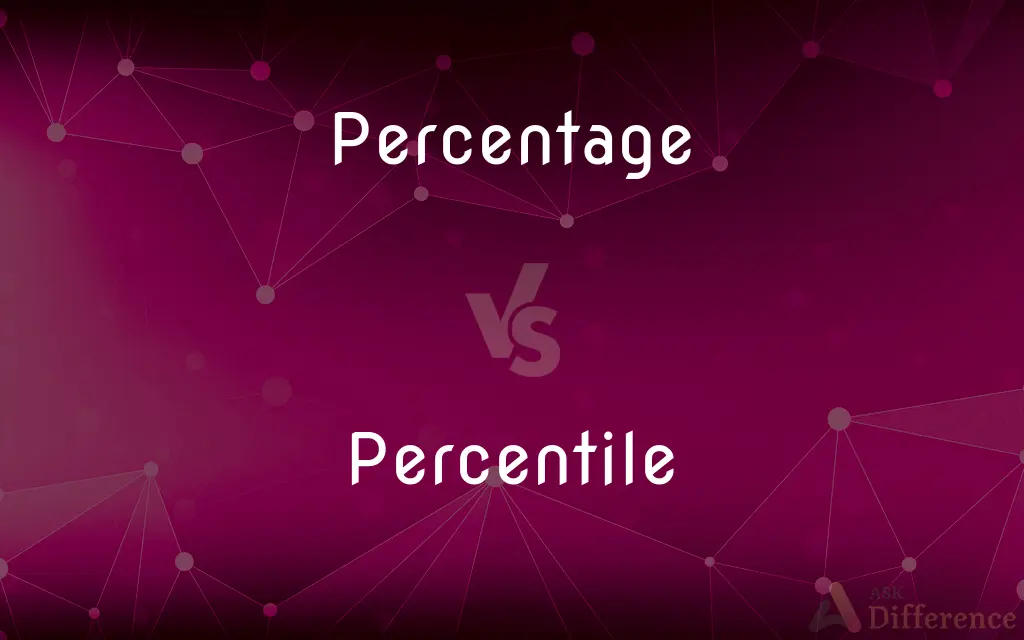Percentage vs. Percentile — What's the Difference?
Edited by Tayyaba Rehman — By Fiza Rafique — Updated on October 10, 2023
"Percentage" refers to a portion of 100, while "Percentile" indicates a data point's position relative to others in a dataset, often in terms of percentage rank.

Difference Between Percentage and Percentile
Table of Contents
ADVERTISEMENT
Key Differences
"Percentage" and "Percentile," while connected through their association with 100-part divisions, articulate different mathematical and statistical concepts. "Percentage" represents a fraction or a ratio expressed out of 100, used widely from mathematics to daily life, illustrating quantities proportionally related to a whole. Conversely, "Percentile" situates itself primarily within the realm of statistics, delineating a specific point’s position relative to other data points in a distribution, providing a comparative understanding of where a particular value stands amidst a dataset.
In elementary mathematics or daily commerce, "Percentage" is a familiar term, implying a straightforward calculation where a part is evaluated as a fraction of 100. This part-to-whole relationship is pervasive in various scenarios, such as calculating discounts, determining profit margins, or evaluating changes in quantities. "Percentile," meanwhile, doesn’t find itself utilized in elementary calculations or daily shopping, instead it elucidates where a particular data point ranks within a larger distribution, thereby furnishing a relative standpoint rather than a direct part-to-whole relationship.
In financial analyses, "Percentage" can illustrate various financial metrics such as interest rates, profitability ratios, or financial growth, becoming a pivotal concept in comprehending financial health and trends. Alternatively, "Percentile" could be invoked to compare a specific data point, such as a company's profit margin, with a broader industry standard or against a wider set of companies, thereby providing a relative comparison that offers insights into the company's performance vis-à-vis its peers or industry norms.
Education often uses "Percentage" to reflect scores or performance, presenting a clear-cut, absolute measurement of achievement. For instance, a test score is commonly presented as a percentage, directly linking the obtained marks to the total marks. "Percentile," however, provides a comparative metric in test scores, delineating a student's performance relative to other test-takers, thereby offering not an absolute measure of performance, but a relative one, assisting in understanding where a student stands amidst peers.
In healthcare, "Percentage" might quantify health metrics or measurements, such as the percentage of patients responding to a particular treatment, thereby providing a straightforward, proportionate measure relating to a larger whole. "Percentile," in contrast, may articulate a patient’s health metric, such as a baby's weight, in relation to a broader population, offering a comparative perspective that assists in understanding the patient's health metric in a broader context, potentially aiding in deriving meaningful insights regarding anomalies or trends.
ADVERTISEMENT
Comparison Chart
Basic Definition
A ratio or fraction out of 100
Ranking of a data point within a distribution
Common Usage Contexts
General, including finance, education, and healthcare
Primarily statistical, used in specific comparative analyses
Application in Measurement
Absolute measurement of a part relative to a whole
Relative measurement of a point amidst a dataset
Mathematical Expression
(Part/Whole) * 100
Ranking within a distribution expressed as a percentage
Relevance in Daily Language
Widely used in various contexts
Limited to specific, often statistical, contexts
Compare with Definitions
Percentage
Percentage is a ratio expressed as a fraction of 100.
A 20% discount means saving 20 dollars per 100 dollars spent.
Percentile
Percentile denotes a data point's rank within a distribution, expressed as a percentage.
Scoring in the 90th percentile means performing better than 90% of the cohort.
Percentage
Percentage represents a specific portion of a total amount.
70% of the class passed the exam.
Percentile
Percentile offers a comparative metric within statistical data.
The company’s profits are in the top 10th percentile of the industry.
Percentage
Percentage quantifies proportional amounts or changes.
The company noted a 15% increase in sales this quarter.
Percentile
Percentile provides a relative standing, comparing one data point to a dataset.
Her height is in the 75th percentile for her age group.
Percentage
Percentage can indicate comparative ratios between different quantities.
The percentage of homeowners is 65% compared to renters at 35%.
Percentile
Percentile can assist in identifying anomalies or outliers within data.
An unexpected spike in sales might be in the 99th percentile.
Percentage
In mathematics, a percentage (from Latin per centum "by a hundred") is a number or ratio expressed as a fraction of 100. It is often denoted using the percent sign, "%", although the abbreviations "pct.", "pct" and sometimes "pc" are also used.
Percentile
Percentile illustrates a data point's position within a distribution, not the value itself.
A 50th percentile rank doesn’t mean he scored 50% on the test.
Percentage
A rate, number, or amount in each hundred
A large percentage increase
The percentage of Caesareans at the hospital was three per cent higher than the national average
Percentile
In statistics, a percentile (or a centile) is a score below which a given percentage of scores in its frequency distribution falls (exclusive definition) or a score at or below which a given percentage falls (inclusive definition). For example, the 50th percentile (the median) is the score below which (exclusive) or at or below which (inclusive) 50% of the scores in the distribution may be found.
Percentage
A fraction or ratio with 100 understood as the denominator; for example, 0.98 equals a percentage of 98.
Percentile
Each of the 100 equal groups into which a population can be divided according to the distribution of values of a particular variable.
Percentage
The result obtained by multiplying a quantity by a percent.
Percentile
Any of the groups that result when a frequency distribution is divided into 100 groups of equal size.
Percentage
A proportion or share in relation to a whole; a part
The hecklers constituted only a small percentage of the audience.
Percentile
Any of the values that separate each of these groups.
Percentage
An amount, such as an allowance, duty, or commission, that varies in proportion to a larger sum, such as total sales
Work for a percentage.
Percentile
(statistics) Any of the ninety-nine points that divide an ordered distribution into one hundred parts, each containing one per cent of the population.
Percentage
(Informal) Advantage; gain
There is no percentage in work without pay.
Percentile
(statistics) Any one of the hundred groups so divided.
He is highly intelligent – he has an IQ in the top percentile.
Percentage
The amount, number or rate of something, regarded as part of a total of 100; a part of a whole.
A high percentage of secondary school leavers take a gap year.
Percentile
(statistics) any of the 99 numbered points that divide an ordered set of scores into 100 parts each of which contains one-hundredth of the total
Percentage
A share of the sales, profits, gross margin or similar.
She gets a percentage for every vacuum cleaner sold.
Percentage
(informal) Benefit or advantage.
There was no percentage in staying at home.
Percentage
A certain rate per cent; the allowance, duty, rate of interest, discount, or commission, on a hundred.
Percentage
A proportion multiplied by 100
Percentage
Assets belonging to or due to or contributed by an individual person or group;
He wanted his share in cash
Percentage
Percentage translates fractions into a uniform base of 100 for ease of comparison.
Scoring 45 out of 50 translates to a percentage of 90%.
Common Curiosities
Does a higher Percentile always indicate a higher absolute value?
Not necessarily, it indicates a higher ranking but not necessarily a higher absolute value.
Is Percentile an absolute measure of value?
No, percentile indicates the relative standing of a data point within a distribution.
Is Percentage used in comparative statistical analyses?
Not commonly, percentages give a direct part-to-whole measure, not a comparative measure like percentiles.
Can Percentile be used to evaluate financial growth?
While possible, percentiles are typically used for ranking, not evaluating absolute growth like percentages.
Can Percentage indicate a data point’s position within a distribution?
No, percentage doesn’t offer data point positioning within a distribution; that’s a function of percentile.
Does Percentage always relate to 100?
Yes, percentage represents a part of a whole, where the whole is considered 100.
How does Percentile relate to Percentage?
Percentile is expressed as a percentage but indicates a ranking within a dataset instead of a part-to-whole ratio.
Is Percentile relevant in day-to-day shopping scenarios?
Rarely, as percentiles communicate comparative ranking in distributions, not straightforward part-to-whole ratios.
Is Percentage relevant in statistical analyses?
Percentage can be used in statistics but doesn’t offer the comparative insights of percentiles.
Can Percentage be used to compare two different quantities?
Yes, percentages can indicate proportions and compare different quantities proportionally.
Is it valid to compare Percentiles across different datasets?
Care should be taken as it may not present an accurate comparison due to differing data contexts.
Can Percentage be over 100%?
Yes, percentages can exceed 100% when representing growth or change exceeding the original amount.
Is Percentile involved in basic mathematical calculations?
Not typically, percentile is primarily used for statistical and comparative analyses.
Can I express Percentage in decimal form?
Yes, a percentage (e.g., 20%) can be expressed as a decimal (0.20).
Does Percentage provide insights into data point rankings within a set?
No, percentage does not provide a comparative ranking within a set, unlike percentile.
Share Your Discovery

Previous Comparison
Convention vs. Protocol
Next Comparison
Rhizome vs. TuberAuthor Spotlight
Written by
Fiza RafiqueFiza Rafique is a skilled content writer at AskDifference.com, where she meticulously refines and enhances written pieces. Drawing from her vast editorial expertise, Fiza ensures clarity, accuracy, and precision in every article. Passionate about language, she continually seeks to elevate the quality of content for readers worldwide.
Edited by
Tayyaba RehmanTayyaba Rehman is a distinguished writer, currently serving as a primary contributor to askdifference.com. As a researcher in semantics and etymology, Tayyaba's passion for the complexity of languages and their distinctions has found a perfect home on the platform. Tayyaba delves into the intricacies of language, distinguishing between commonly confused words and phrases, thereby providing clarity for readers worldwide.














































